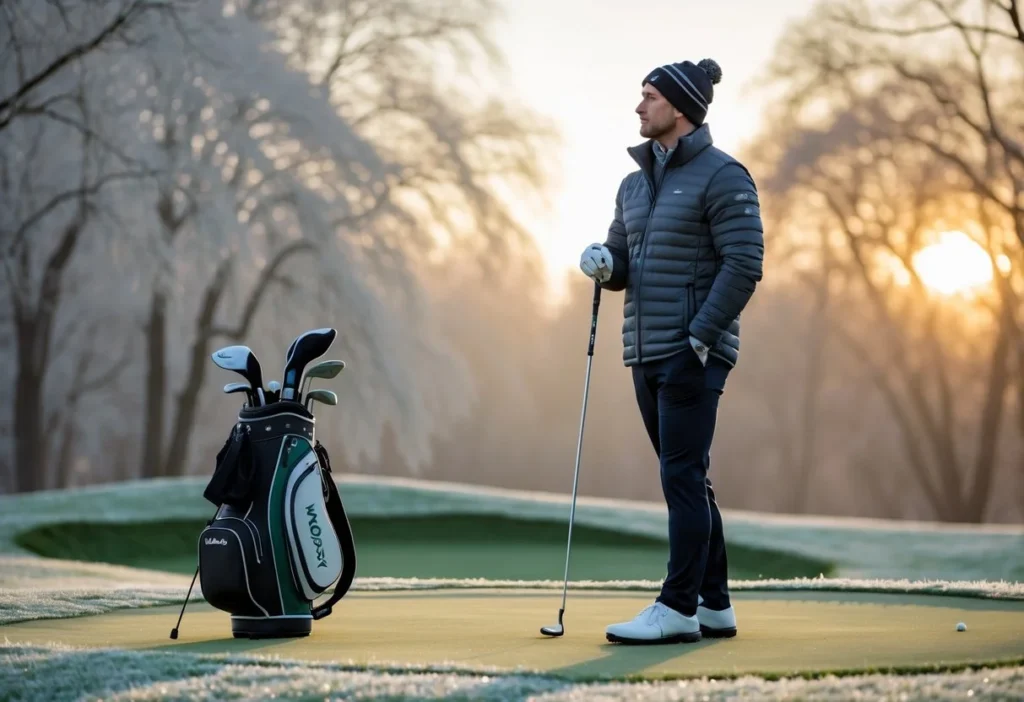
Winter golf doesn’t have to signal the end of your game. With the right gear and a bit of determination, you can keep playing and maybe even get better while everyone else is hibernating.
Dress right, zero in on your short game, and try out some indoor practice tools; these things really help you stay sharp, even when it’s freezing outside.
A golfer in winter clothing standing on a frost-covered golf course with bare trees and soft sunlight in the background.
Lots of golfers tweak their routines for the cold, and honestly, it makes a difference. Whether you’re bundled up outdoors or rolling putts on a mat inside, you can keep your game moving forward.
Setting small goals and mixing in specific drills makes it easier to stay consistent. The cold brings its own challenges, but there’s no reason to let your skills slide.
Some folks actually enjoy winter golf for the quiet, empty courses and no waiting around. Staying active now also helps you come back stronger when spring finally arrives.
Table of Contents
Mastering Winter Golf Techniques
When you play golf in winter, you’ve got to rethink how you dress, what you put in your bag, and how you handle the course. It’s all about staying warm, moving freely, and figuring out how to handle softer ground and slow, mushy greens.
Layering and Clothing Essentials
Layering is the real secret; stay warm without turning into the Michelin Man. Start with a snug base layer that traps heat and wicks away sweat.
That first layer should hug your skin but still let you swing. Next, throw on a light mid-layer; a fleece or wool jumper works well.
Top it off with a quality waterproof and windproof outer jacket. Go for something breathable so you don’t overheat if the sun pops out.
Don’t skip the accessories. A snood or neck warmer keeps the wind off your neck, and winter golf gloves help your grip stay solid and your fingers from going numb.
Base layer trousers and thick socks also help keep your legs and feet from freezing. Trust me, cold toes ruin a round fast.
Adapting to Course and Weather Conditions
Winter courses get squishier and slower, which means your ball won’t roll as much after it lands. Plan to carry the ball further in the air to make up for it.
Wetter, uneven lies mess with your short game, so chipping and pitching from all kinds of turf become even more important.
And the wind? It’s brutal some days. Adjust your stance, tighten up your swing, and keep your shoes clean to avoid sliding around on muddy or icy patches.
Choosing the Right Winter Golf Ball
Cold air makes golf balls feel like rocks, and they don’t fly as far. Pick a ball with a firmer core to help keep your shots from coming up short.
Winter balls might not spin or feel as nice on the greens, but they do give you a bit more distance off the tee. Stash a couple in your pocket to keep them warm for a few bonus yards.
Switching to a distance ball that’s built for soft fairways and slow greens can really help. It’s a small change, but it adds up over a round.
Indoor Practice and Off-Season Improvement
Winter’s actually a great time to work on your game without the pressure of a full round. Grab some tools, set up a few drills, and you can keep your swing in shape indoors.
Practise putting, mess around with new tech, and repeat the basics. You’ll be glad you did when spring shows up.
Effective Putting at Home
Putting it on at home is easy, and honestly, kind of fun. A fancy mat is nice, but a carpet or smooth floor does the trick, too.
Focus on making your stroke smooth and controlling distance, not just sinking putts. Try the gate drill: set two objects just wider than your putter and swing through that narrow gap to keep your path straight.
Put tees at different spots to practise speed and stopping the ball close to each one. Keep track of your results; it’s more motivating than you’d think.
Short, focused sessions, maybe 10 or 20 minutes a few times a week, work best. No need to grind for hours.
Using Golf Simulators Effectively
Golf simulators are a game-changer for winter. They spit out all kinds of data: ball speed, launch angle, spin, and club path, so you know exactly what’s going on with your swing.
When you use a simulator, go for quality over quantity. Work on shaping shots, not just blasting balls into the screen.
You can even play virtual rounds on famous courses, which is a nice bonus. Checking your stats over time helps you see progress and tweak your practice.
Developing Consistency with Practice Drills
Consistency comes from repeating good habits. Winter’s perfect for dialling in your grip, posture, and swing tempo with slow-motion swings indoors.
Lay alignment sticks on the floor to check your setup and swing path. Impact bags help you groove the right feel at contact without needing to hit actual balls.
Using a mirror gives instant feedback; it’s easier to spot what looks off and fix it right away. Filming your swing or keeping a simple log keeps you honest and shows your improvement over time.
Even a few minutes a day makes a difference. It’s not glamorous, but it pays off.
Frequently Asked Questions
How can I keep my hands warm and maintain a good grip while playing?
Grab a pair of winter golf gloves; they’re made for cold, wet days and help you keep your grip. Stick some hand warmers in your pockets or use a warming pouch between shots to keep your fingers working.
Don’t wear gloves that are too bulky, though. You still need to feel the club and move your hands easily.
What are the best strategies for playing on frosty greens?
Frosty greens play slowly, with less break because of the moisture and longer grass. Hit your putts with a bit more force and aim straighter than you normally would.
Spend some time practising on winter greens if you can; it helps you get used to the way the ball rolls (or doesn’t).
Can you recommend any waterproof gear that won’t restrict my swing?
Look for modern golf jackets and trousers; they’re lighter and more flexible than ever but still keep you dry. A good fit is key; you want to stay warm without feeling bulky.
Invest in solid base layers, too. They’ll keep you toasty without weighing you down or making your swing awkward.
What type of golf balls perform best in cold weather?
Firmer golf balls tend to travel further, so they’re a smart pick for winter rounds. Cold air and soft ground just eat up your carry distance.
Sure, these balls might give you less spin and feel around the greens, but picking a distance ball helps you keep some of that yardage when the temperature drops.




